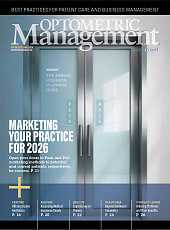SCLERAL LENSES have been around for many years, originally made of glass and later polymethylmethacrylate (PMMA), which created concerns about corneal hypoxia (Bowden and Barnett, 2017). First described in the 1940s, the successful use of holes, or fenestrations, in these lenses created a looser fit and reduced corneal edema symptoms (Bier, 1957; Dallos, 1946; Bier, 1947).
Although fenestrations were commonplace back then, they have not been as widely used since the introduction of GP materials (Fisher et al, 2024). However, there are some circumstances in modern contact lens practice where fenestrations may be considered.
Corneal Edema
Harris and colleagues (1977) demonstrated a reduction in central edema with fenestrated PMMA lenses. Fisher and colleagues (2022) measured corneal edema in 9 young, healthy adults after 90 minutes of open-eye wear of a high-Dk non-fenestrated lens compared to a single 0.3 mm fenestrated scleral lens of the same material. There was no clinically significant difference in central corneal edema.
The authors suggested that while this was not significant in normal corneas, the equivalent 19% reduction in edema with a fenestrated lens may benefit compromised corneas, such as those that have reduced endothelial function following penetrating keratoplasty.
More studies with larger sample sizes in these populations may explain anecdotes describing resolution of scleral lens-induced corneal edema by adding fenestrations. Case reports have described managing edema using more than one scleral fenestration in modern high-Dk scleral lenses (Asghari, 2022; Fadel, 2023).
Optimizing Fit
Fadel and Ezekiel (2020) proposed that fenestrated scleral lenses relieve lens suction, contributing to easier removal and preventing adhesion. They also suggested that fenestrations reduce midday fogging by relieving conjunctival pressure and limiting debris accumulation in the tear reservoir.
Recommendations for fitting include a scleral lens diameter as large as possible, 0.5 mm to 1.0 mm fenestration in the limbal curve, less than 150 µm in the central vault, and at least 75 µm in the limbal vault. Proper limbal clearance is necessary to prevent a large air bubble encroaching on the visual axis and to reduce corneal or limbal bearing. Finally, the fenestration should be rounded and polished to minimize discomfort and debris accumulation.
Intraocular Pressure
A review article by Schornack and colleagues (2023) concluded that studies examining the effect of scleral lenses on intraocular pressure (IOP) are not in agreement. It has been hypothesized that sclerals may increase IOP because of negative suction forces underneath the lens or by impeding aqueous outflow due to tissue compression (McMonnies, 2016).
Fenestrated scleral lenses may lessen this suction to avoid IOP changes (Fadel and Ezekiel, 2020). Conversely, Cheung and colleagues’ study showed a small increase in IOP with fenestrated scleral lens wear (Cheung et al, 2020). They measured IOP on 50 young, healthy adults wearing a 16.5 mm rotationally symmetric scleral lens with a 4 mm central fenestration. There was no post-lens tear reservoir and therefore minimal suction force. They suggested that IOP changes may be associated with tissue compression rather than negative suction. However, Fadel and Ezekiel (2020) discussed limitations to this study and the need for larger fenestrated lenses with asymmetric landing zones to better align and more evenly distribute pressure on the sclera to determine the effect of a fenestrated lens on IOP.
Conclusion
Fenestrated scleral lenses are not routine in modern contact lens fitting, but they may be considered with the goal of minimizing corneal edema, lens suction, and midday fogging. There is not yet a consensus on whether IOP changes can be altered with the addition of fenestrations. There are also some potential comfort issues with fenestrated scleral lenses, but these can be mitigated by optimizing fit.
References
1. Bowden TJ, Barnett M. History of Scleral Lenses. In: Barnett M, Lynette KJ, eds. Contemporary Scleral Lenses, Theory and Application. Sharjah, United Arab Emirates: Bentham Science Publishers; 2017:303-345.
2. Bier N. Contact Lens Routine and Practice. 2nd ed. London, United Kingdom: Butterworths Scientific Publications; 1957.
3. Dallos J. Sattler’s Veil. Br J Ophthalmol. 1946;30: 607–13.
4. Bier N. The Tolerance Factor and Sattler’s Veil as Influenced by a New Development of Contact Lens Making. Am J Optom Arch Am Acad Optom. 1947;24:611–5.
5. Fisher D, Collins MJ, Vincent SJ. Contact lens fenestrations and channels in relation to tear exchange and corneal oedema. Clin Exp Optom. 2024;20:1-14. doi: 10.1080/08164622.2024.2426823
6. Fisher D, Collins MJ, Vincent SJ. Corneal oedema during open-eye fenestrated scleral lens wear. Ophthalmic Physiol Opt. 2022;42(5):1038-1043. doi: 10.1111/opo.13005.
7. Harris MG, Barreto DJ, Matthews MS. The effect of peripherally fenestrated contact lenses on corneal edema. Am J Optom Physiol Opt. 1977;54(1):27-30. doi: 10.1097/00006324-197701000-00003
8. Asghari B. Resolution of bullous corneal edema with use of haptic fenestrations. Poster at Global Specialty Lens Symposium, Las Vegas. January 19-22, 2022.
9. Fadel D. Preventing and managing edema with scleral lenses. Rev Cornea Contact Lenses. 2023 March 15. reviewofcontactlenses.com/article/preventing-and-managing-edema-with-scleral-lenses
10. Schornack MM, Vincent SJ, Walker MK. Anatomical and physiological considerations in scleral lens wear: Intraocular pressure. Cont Lens Anterior Eye. 2023;46(1):101535. doi: 10.1016/j.clae.2021.101535
11. McMonnies CW. A hypothesis that scleral contact lenses could elevate intraocular pressure. Clin Exp Optom. 2016;99(6):594-596. doi: 10.1111/cxo.12368
12. Cheung SY, Collins MJ, Vincent SJ. The impact of short-term fenestrated scleral lens wear on intraocular pressure. Cont Lens Anterior Eye. 2020;43(6):585-588. doi: 10.1016/j.clae.2020.02.003



